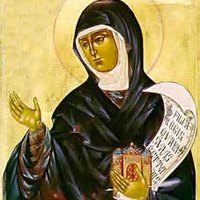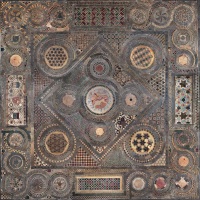C.G. Jung’s Red Book: There it is!
 In this photo provided by the Rubin Museum of Art, the museum’s chief curator, Martin Brauen, left, and Felix Walder, great-grandson to Carl Jung, inspect Carl Jung’s “The Red Book” after it’s arrival at the Rubin Museum of Art in New York Tuesday, Sept. 29, 2009. “The Red Book,” will be displayed to the public for the first time on October 7, coinciding with the first-ever publication of the book by W.W. Norton & Company. (AP Photo/Rubin Museum of Art, Stuart Ramson)
In this photo provided by the Rubin Museum of Art, the museum’s chief curator, Martin Brauen, left, and Felix Walder, great-grandson to Carl Jung, inspect Carl Jung’s “The Red Book” after it’s arrival at the Rubin Museum of Art in New York Tuesday, Sept. 29, 2009. “The Red Book,” will be displayed to the public for the first time on October 7, coinciding with the first-ever publication of the book by W.W. Norton & Company. (AP Photo/Rubin Museum of Art, Stuart Ramson)
NEW YORK, NY.- The preeminent psychologist C. G. Jung (1875-1961) considered his Liber Novus, the famous Red Book, to be the “prima materia for a lifetime’s work.” Many contemporary scholars regard it as the most influential unpublished work in the history of psychology.
Now this cultural touchstone—in which Jung developed his principal theories of archetypes, collective unconscious, and the process of individuation—is to go on public view for the first time in a special showing at the Rubin Museum of Art. Entitled The Red Book of C. G. Jung: Creation of a New Cosmology, the exhibition from October 7, 2009, to January 25, 2010, coincides with a major event in publishing: W.W. Norton & Company’s publication of a facsimile and translation of Jung’s original.
For a book that would transform psychotherapy from a practice concerned with the treatment of the sick into a means for the higher development of the personality, the Red Book is a strange hybrid of thought and image taking the form of a 11.57 x 15.35 inch red leather-bound manuscript. In more than two-thirds of its pages, Jung paired his abstract and narrative brightly hued graphic forms with thoughts written in a beautiful calligraphic style.
The work has never been seen in public before, outside the circle of Jung’s family. Alongside the 95-year old volume which Jung worked on from 1914-1930, the Rubin Museum will present a number of oil, chalk, and tempera paintings and preparatory sketches related to the Red Book and other original manuscripts, including the Black Books, which contain ideas and fantasies leading up to the Red Book. In addition, copies of the new publication will be available for perusal in a reference area in the gallery.
“This exhibition will cast new light on the genesis of Jung’s work and the making of modern psychology, and open up possibilities for understanding how mandalas and mandala-like structures are understood across cultures,” says Martin Brauen, Chief Curator, Rubin Museum of Art.
Dr. Brauen, who is particularly interested in the mandala-like paintings in the Red Book, first encountered Jung’s work as a student at the Jung Institute in Zurich and in his own research into mandalas. “Mandala: The Perfect Circle,” an exhibition he is organizing, will be on view concurrently at the museum with the Red Book this fall.
“Jung described the mandala as an ‘archetype of wholeness,’” continues Brauen. “The Red Book of C. G. Jung is in some way the focal point of all of the exhibitions we will present in Fall and Winter 2009/2010.”
Visitors to the Rubin Museum will be invited to see the ways in which Jung sought to translate the symbols he encountered in dreams and fantasies into contemporary graphic form, often using the circular diagrams of the mandala, which resembles structures represented in Tibetan Buddhist art. On display will be Jung’s first known mandala-like work: Systema mundi totius (1916), a cosmic representation of his reflections on spirituality and the soul, drawn from a series of recorded personal fantasies. Jung considered this work—along with about 25 mandala sketches that he created while serving as a Medical Corps Doctor and Commander of a British internment camp in Switzerland during the last two years of World War I—to be important documentations of his psychological and spiritual development.
The works of art and archival materials included in The Red Book of C.G. Jung are on loan from the Foundation for the Works of C. G. Jung, the Jung family private archive, and private collections.
press release from artdaily.org










A psychology masterpiece. For me, the red book is a reveal of Jung’s rich archetypal world through paintings and text. One of my favorite explorations into the human subconscious and collective unconscious.
Love it!